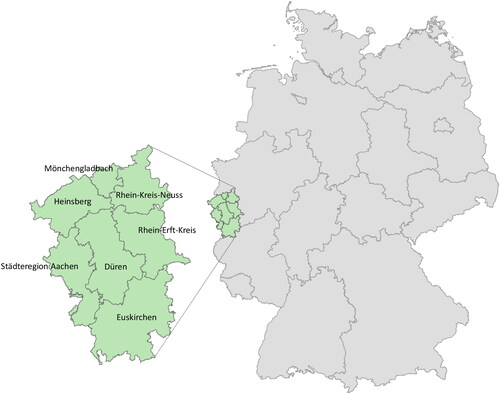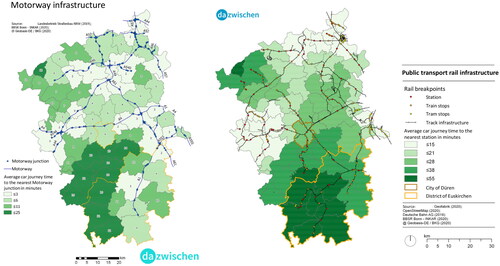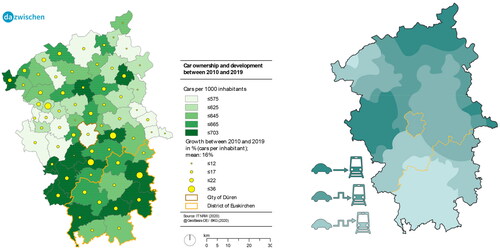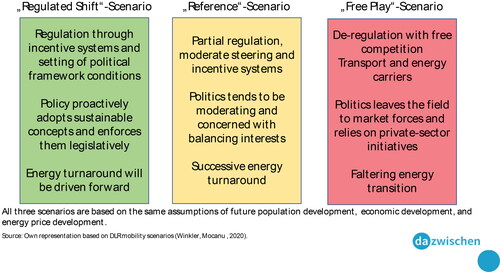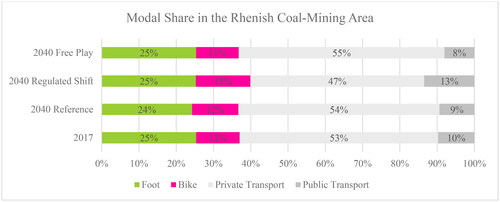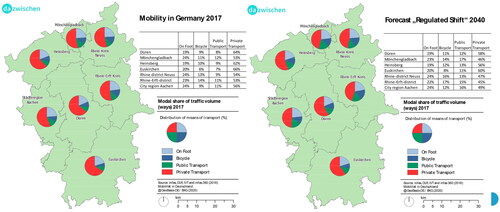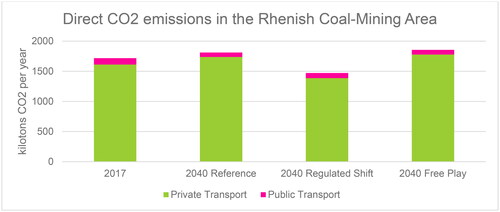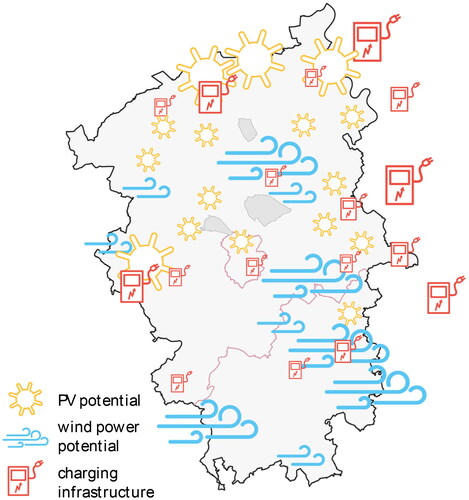Abstract
This article deals with the development of the mobility sector in a very specific area in Germany. The Rhenish coal-mining area has to tackle an ongoing structural change. With the phase-out of lignite-based power generation, (infra-) structural changes and further resulting challenges will arise in the area between Aachen and Cologne in the coming years and decades. Within the framework of the field of action “Mobility” in the Rhenish coal-mining area, the DAZWISCHEN (In Between) (“As of March 17, 2023 the project listed on its website www.zukunftsstadt-stadtlandplus.de/dazwischen-english.html”) is investigating the current spatio-structural state as well as the possibilities for quantitative modelling of individual indicators up to the year 2040.
In this article, “mobility” is understood as the spatial change in the location of people and households in daily life using different means of transport. Against this background, the modal share is considered as the central parameter. This describes the distribution of transport demand among different means of transport. Based on the status quo of the current mobility behaviour of the population in the Rhenish coal-mining area, future scenarios show which measures can be used to reduce CO2 emissions in transport in order to achieve the Paris climate targets. The results can show local decision-makers in the Rhenish coal-mining area which measures are necessary to achieve this.
1. Introduction
So far, greenhouse gas emissions in the mobility sector have hardly decreased. Almost half of the greenhouse gas emissions in the mobility sector are caused by cars and motorbikes. Therefore, the future goal must be a significant reduction in CO2 emissions in the transport sector. Against this background, the question is how will mobility develop in the Rhenish coal-mining area in the future? The development of mobility is also crucial for the future growth of cities. An efficient public transport system is a basic prerequisite for sustainable settlement and mobility development. Cities and municipalities determine which modes of transport can be enabled or excluded. Conversely, transport and its infrastructure also shape the city and its public space. Thus, mobility development has a considerable influence on settlement development and vice versa (Schmidt et al. Citation2013).
The potential for future reductions in transport-related greenhouse gas (GHG) emissions has been studied extensively in the past. These studies have shown that possible pathways towards such a deep reduction in GHG emissions rely heavily on an increased usage of alternative propulsion systems and fuels such as electric vehicles (see, e.g. Andress, Nguyen, and Das Citation2011; McCollum and Yang Citation2009; Bastida-Molina et al. Citation2020; Ehrenberger et al. Citation2021) and, to a lesser extent, also on changes in mobility behaviour and travel patterns, i.e. shifting to more environmentally-friendly modes of transport (see, e.g., Åkerman et al. Citation2021; Carroll, Caulfield, and Ahern Citation2019; O’Riordan et al. Citation2022).
For Germany, previous studies have also revealed possible future scenarios for transport GHG emissions. Hendricks et al. (Citation2018) quantified the climate impact of emissions from land-based transport in Germany. Winkler and Mocanu (Citation2020) presented results pertaining to transport demand in Germany up to the year 2050 for three different scenarios. Likewise, the Baden-Württemberg-Stiftung (BWS) (Citation2017) study relies on three scenarios to model the future development of mobility in the state of Baden-Wuerttemberg.
While previous research has concentrated on nationwide or state-wide developments, this article takes a closer look at mobility development in the Rhenish coal-mining area. So far, there has been no such independent scenario calculation for this region.
This article presents findings from the research project DAZWISCHEN (“As of March 17, 2023 the project listed on its website www.zukunftsstadt-stadtlandplus.de/dazwischen-english.html”), which dealt with the comprehensive structural change in the Rhenish coal-mining area. The goal of the project was to harmonise the regional development with sustainable mobility and environmental concerns. For this purpose, structural changes in mobility patterns were identified and their sub-spatial manifestations were projected quantitatively up to the year 2040, taking into account uncertainties via a scenario corridor.
The aim of this study is to identify possible development paths for the mobility sector in the Rhenish coal-mining area and to derive political recommendations for action. Thus, the results represent an important contribution to complementing the current state of research and support the design of political measures.
In this article, the status quo of the mobility behaviour of the population in the Rhenish coal-mining area is considered at first and presented in the form of regional mode shares. Subsequently, we analyse pre-existing model results pertaining to travel demand in different future scenarios to derive implications for the future mobility development in the Rhenish coal-mining area. Possible developments of sustainable mobility are discussed with a view to renewable energies. In the concluding discussion, we summarise our results and derive recommendations for action for political decision-makers.
2. Current mobility patterns in the Rhenish coal-mining area
The German Federal Ministry of Education and Research’s (BMBF) Sustainable Mobility Research Agenda significantly shapes mobility research. This agenda lists three directions of research: first, the focus on minimizing transport-related emissions; second, ensuring individual needs and social participation for all; and finally, strengthening the competitiveness of communities and overall societal welfare (Bundesministerium für Bildung und Forschung (BMBF) Citation2018). These main aspects of mobility research are often considered with regard to future developments, such as the development of various mobility scenarios in the context of the studies of the Baden-Württemberg-Stiftung (BWS) (Citation2017), Allgemeiner Deutscher Automobil-Club (ADAC) (Citation2017) or acatech (Citation2019).
In order to forecast future developments, current structures and uses of mobility services must be included. Thus, in the following, the transport connections in the Rhenish coal-mining area will be examined in detail and the modal shares for various cities and municipalities in the region will be presented. First, a brief description of the region is given.
2.1. Transport links to the Rhenish coal-mining area
The Rhenish coal-mining area covers an area of 4,977 km2 from the cities of Brühl, Bonn and Euskirchen in the southeast to the Dutch border in the northwest and includes all or part of the districts of Aachen, Düren, Euskirchen and Heinsberg, the Rhine district of Neuss, the Rhine-Erft district and the cities of Cologne and Mönchengladbach (). In total, the Rhenish coal-mining area covers 15% of the area of the federal state of North Rhine-Westphalia (NRW). The approximately 2.4 million inhabitants of the Rhenish coal-mining area represent about 14% of the total population of NRW (Zukunftsagentur Rheinisches Revier [ZRR] Citation2019).
With a total coal reserve of 55 billion tonnes, the Rhenish coal-mining area is the largest lignite deposit in Europe. Almost 100 million tonnes are mined annually in opencast mines (“As of March 17, 2023 the Bund NRW listed on its website www.bund-nrw.de/”). As a result, the landscape in the area has been shaped by this and a number of industrial sites have been created. Due to the decision to phase out electricity generation from lignite and hard coal by 2038, forecasts on future developments are difficult. The coal phase-out in the Rhenish coal-mining area is already in full swing: the first unit of the Niederaußem coal-fired power plant was taken off the grid at the end of 2020 (“Niederaußem D”). Further units at Niederaußem C, Neurath and Weisweiler are to follow at the end of 2021 (Bundesnetzagentur [BNetzA] Citation2021).
Even though the region is embedded in the Rhineland conurbation with the cities of Aachen, Cologne, Düsseldorf and Bonn, it is still characterised by urban-rural contrasts, which are also reflected in the mobility behaviour of its inhabitants.
Where settlement density is high, the transport infrastructure is generally well developed. Here, the distances to public transport stops are shorter and a motorway connection can usually be reached in a few minutes by car. Therefore, the densely populated regions of the Rhenish coal-mining area are well connected to the region’s centres, both in terms of road and public transport, while the rural regions have worse public transport connectivity.
Central cities in the Rhenish coal-mining area are Düren and Euskirchen. The city of Düren is located almost centrally between Aachen and Cologne in the centre of the Rhenish coal-mining area and is well connected via the A4 highway, three main roads and the public transport line from Aachen via Cologne. The local railway Rurtalbahn runs in a north-south direction as a further public transport line.
The district of Euskirchen in the south of the Rhenish coal-mining area is well connected by the Eifel-highway A1, the A61 and the dense network of federal highways and by several railroad lines and connects the nature region Eifel as well as the city triangle of Cologne, Bonn and Aachen supra-regionally. The train connections on the Eifel line (between Cologne and Trier), on the Voreifel-train (between Bonn, Euskirchen and Bad Münstereifel), as well as on the line of the Börde-train (between Euskirchen, Zülpich and Düren), pass through the district of Euskirchen. The latter is a member of the Rhine-Sieg Transport Association and operates many bus routes, including school and tourist services. The excellent mobility connections apply above all to the eastern part of the district and the town of Euskirchen itself. In the less densely populated areas, taxi buses operate on the lines at hourly intervals, subject to prior notification. In the rural, southern part of the district, the population is largely dependent on private cars due to the less frequent and less developed public transport connections ().
2.2. Modal share in the Rhenish coal-mining area
Within the scope of the field of action “Mobility in the Rhenish coal-mining area” in the project DAZWISCHEN (2020–2023) (“As of March 17, 2023 the project listed on its website www.zukunftsstadt-stadtlandplus.de/dazwischen-english.html”), the current mobility patterns and possibilities for quantitative modelling of individual indicators up to 2040 are examined. The existing infrastructure and individual traffic are presented in this section. The modal share is the main indicator chosen to represent the current state. This was last comprehensively surveyed in 2017 as part of the “Mobility in Germany”Footnote1 (MiD) study by the Institute for Applied Social Sciences (infas).
The 2017 MiD is based on a nationwide basic sample of 30,000 households commissioned by the Federal Ministry of Transport and Digital Infrastructure (BMVI) and an additional 106,650 households funded by regional clients, which was exceeded by 15% with a total of 156,420 households. The sample was drawn according to a so-called triple-frame approach via population registers, landline telephone numbers and mobile phone numbers. The survey took place in two phases on a reference date over a survey period from May 2016 to September 2017. In the first phase, a household survey was conducted on, for example, household composition and available means of transport; in the second phase, individual household members were asked about personal characteristics, everyday mobility and journeys made on a reference date.
The modal share analysis deals with the choice of means of transport and is carried out at trip level. It is based on the reporting date-related recording of the distances travelled and shows which means of transport were used ().
For the Rhenish coal-mining area, the distribution of the modal share for each city and district is as follows ().
Table 1. Modal share for cities and districts in the Rhenish coal-mining area (IT NRW 2020).
The high share of motorised individual transport in the Rhenish coal-mining area is particularly striking. There are growth rates of 16% in car traffic in the period from 2010 to 2019, with high growth rates particularly in the rural areas of the Eifel. Thus, private cars play an important role in everyday mobility. Simplified, the following can be stated: The more rural, the higher the proportion of trips made by car.
In Düren and Euskirchen, 64 and 66% of private journeys are made by car respectively. For comparison, in the rest of Germany the share of journeys made by car is around 57%. shows a synthesis of the modal share and the road network. At well over 60%, Heinsberg, Düren and Euskirchen each have high shares of private transport compared to the rest of the Rhenish coal-mining area.
Figure 4. Schematic representation of the modal share (private transport) and road network in the Rhenish coal-mining area and schematic representation of the modal share (public transport) and the line network in the Rhenish coal-mining area.
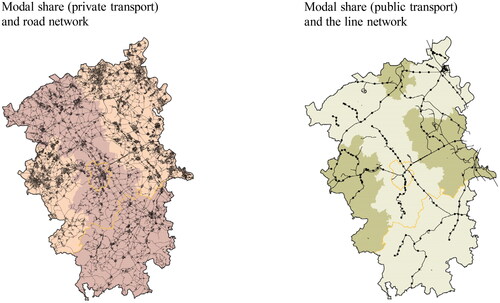
From 2012 to 2021, the number of officially registered cars in the district of Euskirchen increased by 18.1%, so that in 2021, 673.4 cars per 1,000 inhabitants were registered (IT NRW Citation2021). In rural areas, the density of passenger cars is increasing more than in urban regions. However, this general finding can be seen throughout NRW. A mobility transition in the sense of a shift to environmentally friendly means of transport is not in sight in the short term, since the appropriate infrastructure is often still lacking to foster a modal shift from car to public transport or bicycle.
shows a synthesis of the modal share and the rail network in the Rhenish coal-mining area with the opposite result. The largest shares of public transport are found in the direction of Cologne and in more urban areas. Here, the public transport shares amount to about 12%.
shows on the right side a synthesis of the public transport index and access time to stops. Where access times are shortest, shares of public transport are high. In contrast, access times are longest in rural areas, especially in the south of the Rhenish coal-mining area. Where an appropriate public transport service exists, it is used. These results are consistent with Drouilles et al. (Citation2019).
3. Future development of mobility in the Rhenish coal-mining area
The previous analysis has already shown the existing structures and usage patterns of various mobility services in the Rhenish coal-mining area. Following on from this, the future development of mobility in the Rhenish coal-mining region will be investigated on the basis of model results for three scenarios. The role of renewable energies will also be considered and political recommendations for action on mobility will be derived.
3.1. Future scenarios/modelling
The evaluation of the current mobility patterns and most recent developments in the Rhenish coal-mining area show a high and potentially further increasing importance of car traffic instead of the desired mobility transition. This also increases the amount of greenhouse gas emissions with a negative impact on the climate. To achieve the Paris climate targets, greenhouse gas emissions in the mobility sector should be drastically reduced. Consequently, the question arises as to the compatibility of traffic growth and greenhouse gas reductions in the Rhenish coal-mining area.
Forecasts and model calculations are necessary in order to consider long-term trends in the mobility sector and to evaluate their impact on greenhouse gas emissions. Several mobility scenarios for 2040, which had been developed within the institutionally funded project “Transport Development and Environment” at the German Aerospace Center, are presented below and were evaluated specifically for the area of the Rhenish coal-mining area. The three scenarios considered here cover a wide range of conceivable and realistic development paths in the mobility sector and were selected because they offer a comprehensive and concise outlook on the future of mobility and the transport sector in Germany.
The three selected exploratory scenarios were developed using impact uncertainty and cross-impact analyses to ensure their consistency. The first step was to identify the relevant scenario parameters using an impact and uncertainty analysis. Parameters with large impacts on mobility activity and high uncertainty (e.g. public transportation investments, policies, and fiscal regulations) were of particular interest. In a second step, a cross-impact analysis (cf. Weimer-Jehle Citation2006) was performed to identify combinations of input parameters that are internally consistent and thus do not contradict each other. From the resulting nine fully consistent parameter combinations, the following three were selected to represent specific social paradigms. For more information on the “Transport Development and Environment” scenario development process, see Seum, Goletz, and Kuhnimhof (Citation2017) ().
A detailed description of the scenarios and the underlying measures and developments was published in Winkler and Mocanu (Citation2020). The following aspects are particularly relevant here:
The essential framework data (population and economic development) are the same in all three scenarios and correspond to the assumptions of the federal transport forecast 2030 (Bundesministerium für Verkehr und digitale Infrastruktur (BMVI) Citation2014). For the Rhenish coal-mining area, this means a slight population increase of 0.6% in 2040 compared to the base year 2010.
The “Reference” scenario is based on moderate development along foreseeable trends and already adopted mobility policy measures. For example, a slight tightening of CO2 emission performance standards for new passenger car registrations leads to a higher market penetration of hybrid and electric passenger cars. However, stringent modal shifting and directing measures are not assumed in the “Reference” scenario. In the area of transport infrastructure (road and rail network), the focus is on substance maintenance and new construction and expansion measures for all modes of transport equally.
The “Regulated Shift” scenario maps the development of the mobility sector with a clear goal of decarbonisation. To achieve this, regulatory (e.g. speed limits), fiscal (user fees, energy taxes), and infrastructural measures (focus on rail and public transport, promotion of non-motorised transport) are assumed. The aim of these measures is both to shift traffic to environmentally friendly modes and to make private motorised transport more environmentally compatible by switching to low-emission vehicles. Likewise, in the “Regulated Shift” scenario, it is assumed that car ownership (motorisation rate) decreases slightly compared to the other scenarios.
The “Free Play” scenario, on the other hand, depicts a future with less regulatory and policy intervention. The goal of CO2 emission reductions in transport is less prominent and the development of the transport system is more market and demand driven. In this scenario, no technologies are given preferential treatment and infrastructure development focuses more on roads, as there is a greater demand for this mode.
The transport demand was calculated within the framework of the project “Transport development and environment” using the DEMO transport model for the whole of Germany (Winkler and Mocanu Citation2020). DEMO is a macroscopic, multimodal 4-step simulation transport model that considers the entire domestic German passenger transport with all modes (private transport, public transport – bus and train, walking, cycling, flying). Based on differentiated population and structural data (e.g. workplaces, shopping opportunities, school locations, etc.), the travel volume is determined for small spatial units (traffic cells). By considering the effort (e.g. travel time, costs) between individual traffic zones and with individual modes, as well as the preferences of transport users (willingness to pay), the choice of destination and means of transport are calculated. This results in mode-specific origin-destination flow matrices, which can also be assigned to the network model in the next step. The results of the transport model can be used to not only derive mobility-related data (e.g. modal split or kilometres driven), but to also estimate mobility-related greenhouse gas and pollutant emissions. Further information on the model, including a detailed description of model steps, parameters and input/output data can be found in Winkler and Mocanu (Citation2017).
For the present study, only those relations for which the origin, destination or both lie within the Rhenish coal-mining area were evaluated from the Germany-wide DEMO results. The different assumptions and developments in the three scenarios have an impact on the demand for mobility in the Rhenish coal-mining area. Only the “Regulated Shift” scenario succeeds in reducing the private transport modal share compared to the base year 2017 and increase the share of the environmentally-friendly modes. In the other two scenarios, the private transport share will tend to increase even further compared to the base year ().
shows the structural changes in the modal shares in the “Regulated Shift” scenario on a smaller scale.
Even with the assumed (partial) electrification of the passenger car fleet, the model results suggest that direct CO2 emissions from transport in the Rhenish coal-mining area could increase by 5% in 2040 compared to today in the “Reference” and by 8% in the “Free Play.” In contrast, the “Regulated Shift” shows a decrease of 14% (). These savings are insufficient compared to the targets set in the Climate Protection Act. An even faster electrification of the passenger car fleet, promoted by financial incentives and the expansion of the public charging infrastructure, as well as further measures fostering a modal shift (making ecologically-friendly modes more attractive and increasing the price of private cars) could be necessary to achieve the climate targets (Bundesministerium für Verkehr und digitale Infrastruktur (BMVI) Citation2014).
3.2. Possibilities for developing the Rhenish coal-mining area into a sustainable mobility region
In view of the forecast results from the previous section, it is clear that the mobility sector will increasingly be the focus of the debate surrounding climate protection and greenhouse gas reductions in the future. So far, the mobility sector has not been able to meet its reduction targets. On the contrary, transport-related emissions have actually increased. The COVID-19 pandemic lockdown phases have significantly reduced traffic volumes in the meantime, but once the stringent measures ended, emissions have approached their usual levels again, at least in everyday mobility. This still raises the question of how daily mobility can contribute to reducing pollution. A look back at the development of mobility demand shows that appeals, waiting and the hope for insight and changes in the behaviour of citizens alone did not have the desired impact when considering the situation in Germany as a whole.
The time series available in the study “Mobility in Germany” from 2002, 2008 and 2017 shows little change between the shares of car traffic, public transport and cycling. Although the use of bicycles has increased above average in relation to the passenger kilometres travelled, the increases in kilometres travelled by car traffic offset this development. This is not affected even by (modest) increases in public transport. In addition, the increase in absolute kilometres travelled by car is supplemented by a high increase in long-distance public transport, which worsens the CO2 balance due to the growing number of kilometres (Follmer and Schelewsky Citation2021).
In general, sustainable forms of mobility are considered to be the means of transport of the so-called environmental alliance. In addition to walking and cycling, this includes public transportation. Furthermore, newer concepts have become established that seem suitable for reducing private car ownership (car sharing), making car use more environmentally compatible through electric drives, or more effective through carpooling. These concepts have been available for several years, but have not yet been able to counteract the further increase in car ownership and the importance of the car in everyday mobility. Carsharing can contribute to the reduction of private car ownership; electric vehicles to the reduction of emissions from car use impacting the environment and climate; and carpooling to the more effective use of cars. These three alternatives are expected to have the potential to make individual mobility choices more flexible and to open them up to more environmentally and climate-friendly alternatives, without completely excluding the use of cars – an intermediate step on the way towards climate-neutral everyday mobility. A good cycle and pedestrian network, as well as reliable and comfortable public transport, support the transformation of the mobility sector, which is reflected in people turning away from car-dominated everyday mobility and supporting alternative environmentally and climate-friendly mobility options (Gruschwitz forthcoming).
The rural areas of the Rhenish coal-mining area have a low population density. In these areas it is difficult to establish attractive public transport services. With demographic change and increasing migration, mobility is also becoming a social issue in these regions. This in turn affects the financing of public transport in sparsely populated areas. Micro-public transport systems such as on-demand traffic, which, due to their flexibility, maintain everyday mobility in rural areas, provide a possible solution and can be an opportunity to guarantee and expand mobility in rural areas (Bilderl Citation2020).
Nature-compatible tourism always includes the improvement of tourism infrastructure. For example, the accessibility of tourist destinations such as the planned lake landscape should include public transport connectivity and a decentralised charging infrastructure. Sustainable, target group-specific mobility services, possibly even going beyond the current state-of-the-art, will be available in the future and could be successful if they are fast, convenient and inexpensive. Sufficient accessibility of public services for all population groups is a key factor in creating equal living conditions, especially in rural areas (Ahlmeyer Citation2020).
Automated and connected transport could potentially bring several benefits and improvements. However, a literature review also reveals unresolved challenges and scepticism regarding the positive effects in contrast to the expected benefits. Against the background of increasing urban-rural disparities, the potential of automated and connected transport to reduce existing imbalances is questionable. Whether and how this can be achieved depends in a special way on the political and planning framework.
Mobility in the Rhenish coal-mining area must be viewed against the backdrop of the innovative and digital developments in the transport sector in the coming years and the specific structural changes in the region. The main objective should be to reduce CO2 emissions and expand renewable energies. In order to reduce the volume of traffic, the provision of public services in rural areas should be expanded. The local coverage of basic needs is essential, for example, through the revival of corner shops in rural areas and the mobile supermarket, with e-bus and charging facilities at a central location in the village.
3.2.1. Renewable energies as a key element of sustainable mobility
Renewable energies and technologies are highly relevant for the Rhenish coal-mining area. Photovoltaic (PV) systems on roofs, onshore wind energy, battery storage, geothermal energy, power-to-heat (heat pump), cogeneration, electric vehicles and activation of decentralised flexibilities are examples of this. The active opencast mining areas in particular show great potential for the development of renewable energy (RE) plants. Thus, if open pit areas were fully utilised, over 5 GW of RE power generation could be installed. PV will become, and already is, an essential component of renewable electricity generation. In the Rhenish coal-mining area, it will be necessary to aim for a full expansion of PV installations over the next decades, both in opencast mines and on other suitable sites. PV is characterised by its established technology, which has recently become relatively inexpensive. The main disadvantages are the low full-load hours and the typical bell-shaped generation characteristic, which make storage and/or conversion necessary for its contribution in the winter. Due to the higher energy density of wind compared to solar radiation, wind energy (onshore) offers the possibility of ample renewable electricity generation on a relatively small area. Compared to PVs, it also has significantly higher full-load hours and complements the bell-shaped feed-in curve of PV, since the wind blows strongly not only during the day and more in the winter months. The technology is mature and available on the market (Nailis and Unruh Citation2020).
shows the PV and wind energy potential and the electric vehicle charging infrastructure. Sufficient potential for solar and wind power is available in the Rhenish coal-mining area, but there is still not enough charging infrastructure, which is mainly only available in urbanised areas, where public transport is anyway in higher demand.
3.2.2. Possible mobility policy measures
The ecological U-turn in mobility can only take place with the acceptance and participation of citizens. Ingrained behavioural routines must change if a transformation away from a historically evolved system of car-centredness to a sustainable system of networked mobility based on the Internet of Things and automated forms of mobility were to be achieved. Both cultural aspects and technical innovations play a decisive role here. Furthermore, new digital mobility concepts should always consider the social dimension, i.e. access to mobility for all income levels.
Mobility policy could set the necessary framework conditions for this and promote public transport with high levels of investment to encourage more people to travel by bus and train. Conversely, regulatory measures (push measures) such as a speed limit on highways, car tolls according to emissions or an increase in the price of parking tickets could lead to a reduction in car traffic. The renovation and expansion of the public transport infrastructure could also be driven forward, with the aim of redistributing land in favour of the eco-modes of transport.
Already planned road construction projects should be well considered. Funding to expand the commuter rail network and to improve the bicycle infrastructure could be increased. North of the Eifel foothills in the south of the Rhenish coal-mining area, the flat topography lends itself particularly well to a significant expansion of bicycle traffic. At central stations in the region, such as Düren and Euskirchen, the stations could also serve as mobility hubs, providing secure bicycle parking facilities and alternative means of transport for the “last mile” (“As of March 16, 2021, the Grüne-Fraktion listed on its website https://gruene-fraktion-nrw.de/parlament/verkehrswende-im-rheinischen-revier-auf-den-weg-bringen/”).
For the Rhenish coal-mining area, a comprehensive plan for the expansion of the rail and public transport network is being developed together with the relevant stakeholders and in coordination with the Zukunftsagentur Rheinisches Revier (Agency for the Future in the Rhenish coal-mining area), targeting the following goals:
Upgrading of existing regional rail lines to independent commuter rail lines and re-opening of the existing coal railroad for rail traffic.
Expansion and electrification of existing public transport and rail freight lines and identification of further sensible routes including several aspects of security (ETCS, abolition of level crossings, etc.). In particular, there is scope for action in expanding the Aachen–Jülich–Bedburg–Düsseldorf and Mönchengladbach–Erkelenz–Düren–Cologne axes and closing the Linnich-Baal gap. Overall, as many commercial areas as possible and all inhabited areas should be connected to the rail infrastructure.
Review of the planned road construction projects with regard to their necessity for traffic, while also considering aspects of climate protection, land use, protection of the environment and species, noise protection, and the overall status of the network.
Refrain from the planned construction of the highway A61n after the end of lignite mining. To this end, negotiations must be initiated with the energy supply company RWE and the federal government to reallocate the funds for other transport purposes.
Implementation of mobile stations at all regional stops and other important connection points, establishment of a user-friendly car- and bike-sharing service and construction of a supra-local bicycle route network plan.
Expansion of the digital infrastructure to implement technical developments such as autonomous driving, ride sharing, real-time information, etc.
4. Discussion and conclusion
The Rhenish coal-mining area is undergoing structural change as a result of the decision to phase out coal. Therefore, the goal for the Rhenish coal-mining area is to become a model region for sustainable mobility concepts. In order to identify possible developments for the Rhenish coal-mining area, the research project DAZWISCHEN (“As of March 17, 2023 the project listed on its website www.zukunftsstadt-stadtlandplus.de/dazwischen-english.html”) considered three scenarios that depict different developments up to 2040, while looking at sustainability and environmental aspects. Two of the scenarios presented, the “Reference” scenario and the “Free Play” scenario, do not succeed in making mobility sustainable and environmentally friendly, as the evaluation of the DEMO model results shows. Even if the share of hybrid and electric cars increases in the “Reference” scenario, the private transport mode share increases in both scenarios. An increase in CO2 emissions is also to be expected in both scenarios, by 5% in the “Reference” and 8% in the “Free Play.” Only in the “Regulated Shift” scenario, is it assumed that the degree of motorisation will fall, individual mobility will decrease and CO2 emissions will be reduced by 14%. However, it is critical to see that the climate targets cannot be achieved in all the scenarios presented. This can only be achieved by increasing the attractiveness of ecomobility with environmentally friendly modes and increasing the cost of motorised individual transport (Bundesministerium für Verkehr und digitale Infrastruktur [BMVI] Citation2014). The results show that without regulations and incentives through policies the ecological mobility transition cannot be achieved.
Our results tie in with existing mobility research, which refers to Germany as a whole or to entire federal states. Consistent with the existing research we conclude that both a change in mobility behaviour towards more environmentally friendly means of transport and the use of new technologies such as electric vehicles are necessary to achieve the climate targets. By focusing on a specific region, the Rhenish coal-mining area, the DAZWISCHEN (“As of March 17, 2023 the project listed on its website www.zukunftsstadt-stadtlandplus.de/dazwischen-english.html”) concentrates on the mobility behaviour in this region and can thus offer suggestions for actions tailored to the region, as presented in Section 3.2.2, taking into account the individual scenarios. Through the recommendations for action, the Rhenish coal-mining area can become a model region for sustainable mobility and drive it forward. Other regions can follow this example and thus advance the mobility transition on a large scale.
Notes
1 Mobility in Germany is a nationwide survey of households on their everyday transport behaviour commissioned by the Federal Ministry of Transport and Digital Infrastructure. It is conducted approximately every five years (infas, DLR, and IVT and infas 360 360, Citation2018).
References
- acatech. ed. 2019. Mobilität und Klimaschutz. Gesellschaftliches Problembewusstsein und individuelle Veränderungsspielräume. Eine Umfrage des Instituts für Demoskopie Allensbach im Auftrag von acatech [Mobility and climate protection. Social awareness of problems and individual scope for change. A survey conducted by the Allensbach Institute for Public Opinion commissioned by acatech]. www.acatech.de/publikation/mobilitaet-und-klimaschutz/download-pdf?lang=de.
- Ahlmeyer, F. 2020. “Erreichbarkeitsmodellierung in ländlichen Räumen.” [Accessibility Modeling in Rural Areas]. Mobilität – Erreichbarkeit – Ländliche Räume. Thünen-Institut für ländliche Räume. Wissenschaftliche Konferenz, 17–18 Mar 2020, Braunschweig. https://literatur.thuenen.de/digbib_extern/dn062125.pdf.
- Åkerman, J., A. Kamb, J. Larsson, and J. Nässén. 2021. “Low-Carbon Scenarios for Long-Distance Travel 2060.” Transportation Research Part D: Transport and Environment 99: 103010. doi:10.1016/j.trd.2021.103010.
- Allgemeiner Deutscher Automobil-Club (ADAC). ed. 2017. Die Evolution der Mobilität. Eine Studie des Zukunftsinstituts im Auftrag des ADAC [The Evolution of Mobility. A Study by the Agency for the Future on Behalf of ADAC]. www.zukunftsinstitut.de/fileadmin/user_upload/Publikationen/Auftragsstudien/ADAC_Mobilitaet2040_Zukunftsinstitut.pdf.
- Andress, D., T. D. Nguyen, and S. Das. 2011. “Reducing GHG Emissions in the United States’ Transportation Sector.” Energy for Sustainable Development 15 (2): 117–136. doi:10.1016/j.esd.2011.03.002.
- Baden-Württemberg-Stiftung (BWS). ed. 2017. “Mobiles Baden-Württemberg –Wege der Transformation zu einer nachhaltigen Mobilität.” [Mobile Baden-Württemberg – Paths of Transformation to Sustainable Mobility]. Schriftenreihe der Baden-Württemberg-Stiftung, 87. https://www.bwstiftung.de/fileadmin/bw-stiftung/Publikationen/Bildung/Bildung_Mobiles_BW_Nr._87.pdf.
- Bastida-Molina, P., E. Hurtado-Pérez, E. Penalvo-López, and M. Moros-Gómez. 2020. “Assessing Transport Emissions Reduction While Increasing Electric Vehicles and Renewable Generation Levels.” Transportation Research Part D: Transport and Environment 88: 102560. doi:10.1016/j.trd.2020.102560.
- Bilderl, B. 2020. “Mikro-ÖV-Systeme als Mobilitätschance im ländlichen Raum.” [Micro Public Transport Systems as a Mobility Opportunity in Rural Areas].” Mobilität – Erreichbarkeit – Ländliche Räume. Thünen-Institiut für ländliche Räume. Wissenschaftliche Konferenz, 17–18 March, Braunschweig. https://literatur.thuenen.de/digbib_extern/dn062125.pdf.
- Bundesministerium für Bildung und Forschung (BMBF). 2018. Forschungsagenda Nachhaltige urbane Mobilität [Sustainable Urban Mobility Research Agenda]. Bonn. https://www.fona.de/medien/pdf/Forschungsagenda_Nachhaltige-Urbane-Mobilitat.pdf.
- Bundesministerium für Verkehr und digitale Infrastruktur (BMVI). 2014. Verkehrsverflechtungsprognose 2030. Zusammenfassung der Ergebnisse [Traffic Flow Forecast 2030. Summary of the Results]. www.bmdv.bund.de/SharedDocs/DE/Anlage/G/verkehrsverflechtungsprognose-2030-zusammenfassung-los-3.pdf?__blob=publicationFile.
- Bundesnetzagentur (BNetzA). 2021. https://www.bundesnetzagentur.de/SharedDocs/Mediathek/Monitoringberichte/Monitoringbericht_Energie2021.pdf?__blob=publicationFile&v=6
- Carroll, P., B. Caulfield, and A. Ahern. 2019. “Modelling the Potential Benefits of Increased Active Travel.” Transport Policy 79: 82–92. doi:10.1016/j.tranpol.2019.04.020.
- Drouilles, J., S. Aguacil, E. Hoxha, T. Jusselme, S. Lufkin, and E. Rey. 2019. “Environmental Impact Assessment of Swiss Residential Archetypes: A Comparison of Construction and Mobility Scenarios.” Energy Efficiency 12 (6): 1661–1689. doi:10.1007/s12053-019-09811-0.
- Ehrenberger, S., S. Seum, T. Pregger, S. Simon, G. Knitschky, and U. Kugler. 2021. “Land Transport Development in Three Integrated Scenarios for Germany – Technology Options, Energy Demand and Emissions.” Transportation Research Part D: Transport and Environment 90: 102669. doi:10.1016/j.trd.2020.102669.
- infas, DLR, IVT und infas 360. 2018. Mobilität in Deutschland (im Auftrag des BMVI). https://www.mobilitaet-in-deutschland.de/archive/pdf/MiD2017_Ergebnisbericht.pdf
- Follmer, R., and M. Schelewsky. 2021. “Ungerechte Klimabilanz? Eine Analyse Der CO2-Fußabdrücke Im Alltagsverkehr.” [Unfair Climate Footprint? An Analysis of the CO2 Footprints in Everyday Traffic].” WSI-Mitteilungen 74 (3): 241–245. doi:10.5771/0342-300X-2021-3-241.
- Gruschwitz, D. forthcoming. Nutzergruppenorientierte Transformation des Verkehrssektors am Beispiel der Automobilität [User Group-Oriented Transformation of the Transport Sector Using the Example of Automobility].
- Hendricks, J., M. Righi, K. Dahlmann, K.-D. Gottschaldt, V. Grewe, M. Ponater, R. Sausen, et al. 2018. “Quantifying the Climate Impact of Emissions from Land-Based Transport in Germany.” Transportation Research Part D: Transport and Environment 65: 825–845. doi:10.1016/j.trd.2017.06.003.
- IT NRW. 2021. IT NRW – Statistik und IT-Dienstleistungen [IT NRW – Statistics and IT Services]. www.it.nrw/sites/default/files/itnrw_presse/30_21.pdf
- McCollum, D., and C. Yang. 2009. “Achieving Deep Reductions in US Transport Greenhouse Gas Emissions: Scenario Analysis and Policy Implications.” Energy Policy 37 (12): 5580–5596. doi:10.1016/j.enpol.2009.08.038.
- Nailis, D., and O. Unruh. 2020. Ein Energiesystem der Zukunft für das Rheinische Revier [An Energy System of the Future for the Rhenish Mining Area]. www.bet-energie.de/fileadmin/redaktion/PDF/Studien_und_Gutachten/BET-BUW-Studie-Energiesystem-Rheinisches-Revier.pdf.
- O’Riordan, V., F. Rogan, B. Ó. Gallachóir, T. Mac Uidhir, and H. Daly. 2022. “How and Why We Travel – Mobility Demand and Emissions from Passenger Transport.” Transportation Research Part D: Transport and Environment 104: 103195. doi:10.1016/j.trd.2022.103195.
- Schmidt, J. A., H. Jansen, H. Wehmeyer, and J. Garde. 2013. Neue Mobilität für die Stadt der Zukunft [New Mobility for the City of the Future]. https://www.stiftung-mercator.de/content/uploads/2020/12/Neue_Mobilitaet_fuer_die_Stadt_der_Zukunft_Gesamtergebnisse.pdf.
- Seum, S., M. Goletz, and T. Kuhnimhof. 2017. “Verkehrssystemforschung Am DLR – Mobil in Deutschland 2040. Teil 1: Der Methodische Ansatz Im Projekt Verkehrsentwicklung Und Umwelt. “[Transport Systems Research at DLR – Mobile in Germany 2040. Part 1: The Methodological Approach in the Transport Development and Environment Project].” Internationales Verkehrswesen 69 (1): 60–63. https://elib.dlr.de/111463/.
- Weimer-Jehle, W. 2006. “Cross-Impact Balances: A System-Theoretical Approach to Cross-Impact Analysis.” Technological Forecasting and Social Change 73 (4): 334–361. doi:10.1016/j.techfore.2005.06.005.
- Winkler, C., and T. Mocanu. 2017. “Methodology and Application of a German National Passenger Transport Model for Future Transport Scenarios.” Proceedings of the 45th European Transport Conference, 4–6 October, Barcelona.
- Winkler, C., and T. Mocanu. 2020. “Impact of Political Measures on Passenger and Freight Transport Demand in Germany.” Transportation Research Part D: Transport and Environment 87: 102476. doi:10.1016/j.trd.2020.102476.
- Zukunftsagentur Rheinisches Revier (ZRR). ed. 2019. Wirtschafts-und Strukturprogramm 1.1 für das Rheinische Zukunftsrevier [Economic and Structural Program 1.1. for the Rhenish Future Region]. Jülich. www.rheinisches-revier.de/wp-content/uploads/2022/04/wsp_1.1.pdf.

